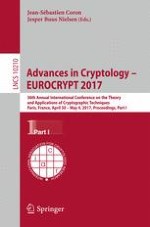2017 | OriginalPaper | Buchkapitel
Computing Generator in Cyclotomic Integer Rings
A Subfield Algorithm for the Principal Ideal Problem in and Application to the Cryptanalysis of a FHE Scheme
verfasst von : Jean-François Biasse, Thomas Espitau, Pierre-Alain Fouque, Alexandre Gélin, Paul Kirchner
Erschienen in: Advances in Cryptology – EUROCRYPT 2017
Aktivieren Sie unsere intelligente Suche, um passende Fachinhalte oder Patente zu finden.
Wählen Sie Textabschnitte aus um mit Künstlicher Intelligenz passenden Patente zu finden. powered by
Markieren Sie Textabschnitte, um KI-gestützt weitere passende Inhalte zu finden. powered by
